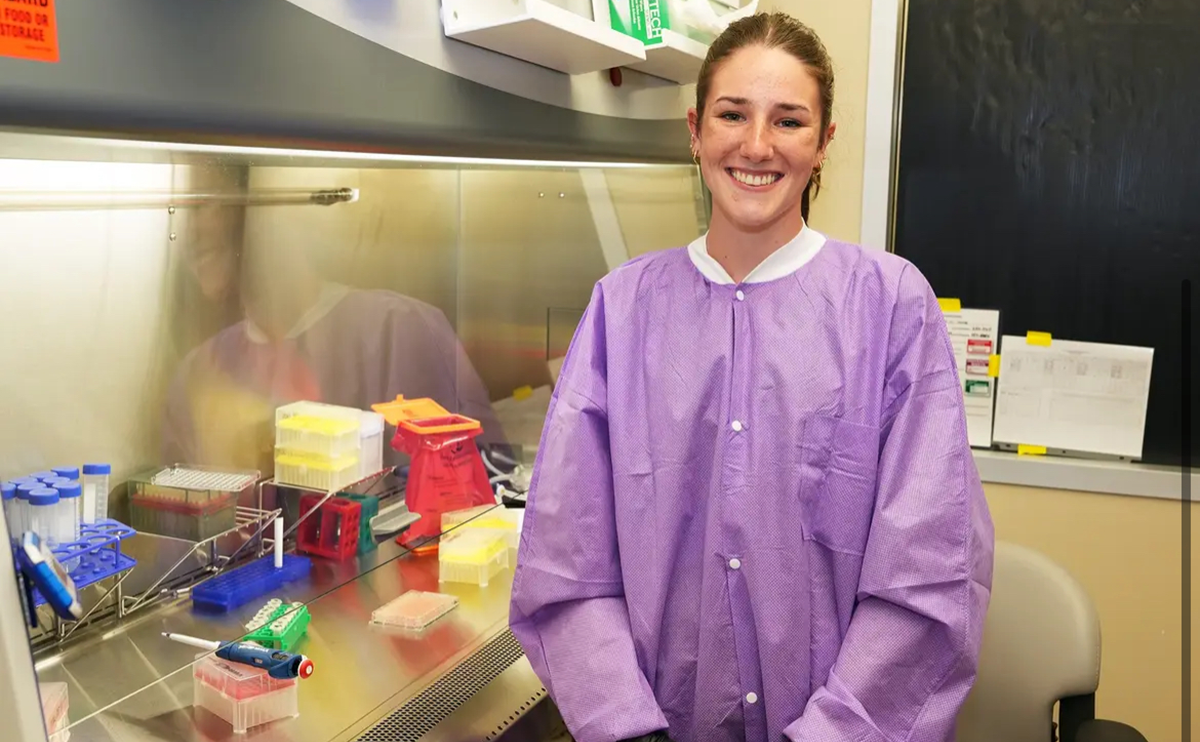Student Intern's Research Helps Advance Wound Healing for Military
Liliane Moorhead spends summer at a Navy laboratory studying the effects of radiofrequency radiation to improve treatment for directed energy injuries.
Biology major Liliane Moorhead spent her summer advancing critical biomedical research through a prestigious internship at the Naval Medical Research Unit (NAMRU) San Antonio, located on Joint Base San Antonio-Fort Sam Houston, Texas. Her work focused on the effects of radiofrequency radiation on immune and vascular cells of the body.
Part of a select group of 10 interns, Moorhead immersed herself in laboratory research, spending full days conducting experiments under the guidance of federal research scientists. She developed a cell model to study immune responses to directed energy exposure, performed real-time reverse transcriptase quantitative PCR (RT-qPCR) to analyze changes in gene expression, and tested barrier permeability using transepithelial electrical resistance (TEER) assays.
NAMRU San Antonio, part of Navy Medicine Research & Development (NMR&D), conducts gap-driven combat casualty care, craniofacial, and directed energy research in support of Navy, Marine Corps and joint U.S. warfighter health readiness and lethality while engaged in routine and expeditionary operations.
Moorhead's internship was supported as part of a larger project funded by the Office of Naval Research’s Naval Research Enterprise Internship Program (NREIP). NREIP places college students in Department of the Navy laboratories where they participate in Naval research for 10 weeks during the summer.
"I was in the lab pretty much all eight hours of my day,” Moorhead said. “RT-qPCR was a completely new technique that I learned, and that allowed us to see 84 different genes that were expressed after exposure. That initial piece was about probably four weeks, then we moved on to the barrier permeability work for two weeks. We used a system that sent electrical pulses through the cell barrier to determine the permeability. We did this in a co-culture with the monocytic cells, transformed to show a macrophage phenotype."
This research is significant because it enhances understanding of how directed energy-related injuries affect wound healing, potentially informing the development of improved post-exposure treatment approaches. Direct energy injuries are damage caused by concentrated energy beams which can cause skin burns, eye damage, and internal thermal trauma. The focused energy heats the target tissue, leading to cellular damage, swelling, and potentially severe systemic effects. Injuries from electrical energy, where current passes through the body, are also a type of direct energy injury, causing internal burns, muscle damage, and nerve issues.
Prior to her internship, Moorhead hadn't considered government positions. She discovered the internship listed on Lehigh's Handshake career management platform and was drawn by the connections between the research taking place in Texas and research she was conducting as a member of biological sciences professor Linda Lowe-Krentz's laboratory.
"I had prior experience working with endothelial cells in Professor Lowe Krentz's lab, and the lab I was interested in had a focus on similar research," she said. "I highlighted that connection in my application, and the shared expertise helped get my foot in the door."
I would do the internship again in a heartbeat. The biggest thing I took away from it is the effort you put in is what you get out of it. This was something I really wanted to do, and I put a lot of effort into the work I was doing. It provided me with a lot of awesome results, results that are going to be used for more studies in their lab.

Her summer work builds directly on the training she receives at Lehigh in the Lowe-Krentz laboratory, where she studies endothelial cells and angiogenesis. At Lehigh, she has investigated how Heparin impacts the function of integrins and TMEM184A in how they regulate cell migration.
"The internship definitely built up my cell culture skills but I think the biggest thing that I gained from this internship was just confidence in doing research and speaking about it, presenting it, as well. I'll definitely apply that to the work I'm doing this semester," she said. "The biggest thing that I had to overcome was just admitting to myself when I was doing too much. I am a perfectionist. I like to go all the time, but there were points where I had to admit to myself that, 'Hey, I don't know how to do this or this is my first time doing it.’ That was one of the biggest things I needed to learn, that it is OK to mess up and it is OK to ask for help."
Moorhead is spending her last semester back in the Lowe-Krentz laboratory, which is identifying and characterizing a receptor for heparin in vascular cells. The team has identified the receptor protein, determined much of a signal transduction pathway that modulates smooth muscle and endothelial cell proliferation, migration and also angiogenesis, and is currently extending that work to determine the mechanisms by which heparan sulfate proteoglycans also interact with the receptor and participate in controlling vascular cell function.
Moorhead, who plans to pursue an M.D.-Ph.D. after graduation, said her experiences at Lehigh and at NAMRU San Antonio have confirmed her passion for research.
"Going into college, I didn't think I wanted to do research," she said. " When I'm in the lab, it feels right — I feel like I'm in the right place. I would do the internship again in a heartbeat. The biggest thing I took away from it is the effort you put in is what you get out of it. This was something I really wanted to do, and I put a lot of effort into the work I was doing. It provided me with a lot of awesome results, results that are going to be used for more studies in their lab. I think it just kind of was reassuring that I put a lot of effort into the work I was doing, and I got good things out of it.”

